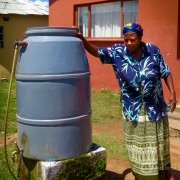Too Soon To Know Hospital Compliance with Federal Government Legionella Policy
Hospitals and nursing homes that receive government payments were ordered in June 2017 to pay greater attention to harmful bacteria in their plumbing systems.

Rooftop cooling towers are a common breeding ground for Legionella bacteria. Photo courtesy of Flickr/Creative Commons user Theen Moy
By Brett Walton, Circle of Blue
Federal health officials say that it is too soon to know how many Medicare providers are complying with a government agency’s order to reduce the risk of Legionnaires’ disease, the deadliest waterborne illness in the United States.
A division of the Department of Health and Human Services, the Centers for Medicare and Medicaid Services (CMS) reimburses hospitals and nursing homes for providing healthcare to recipients of those two government programs.
A June 2017 memo from the CMS Quality and Safety Oversight Group ordered these facilities to follow nationally accepted guidelines for maintaining plumbing systems, testing water, and assessing risk for Legionella, the bacteria that cause the deadly, pneumonia-like disease. Spread by inhaling contaminated droplets, the bacteria flourish in warm, stagnant water found in pipes, faucets, showerheads, fountains, hot tubs, and heating and cooling units. The disease is not contracted by drinking contaminated water.
According to CMS, the memo applies to 15,688 nursing homes and 6,862 hospitals, which includes children’s care, psychiatric, and rehabilitation centers. Adherence to the Legionella management standards outlined in the memo will be checked during regularly scheduled compliance surveys — but some of those evaluations are still more than a year away.
Management of building plumbing systems is our biggest prevention tool right now.” — Laura Cooley, CDC
“Nursing homes are surveyed annually and hospitals every three years,” David Wright, acting deputy director of the CMS Center for Clinical Standards and Quality, told Circle of Blue in an email. “The memo on water-management plan guidance was published in June 2017. Data on facilities tested will be compiled as the results of the surveys are received.”
CMS was unable to say how many of the compliance surveys completed since the memo’s publication have found inadequate Legionella management plans.
Engineers and scientists who work on Legionella say that the CMS memo is an essential step for preventing the disease.
“It’s absolutely, critically important,” Tim Keane, an engineer who runs Legionella Risk Management, a Pennsylvania-based consultancy, told Circle of Blue. “I think the healthcare industry has ignored the issue.”
Keane said that fostering greater awareness of Legionella risk among CMS facilities was the one action that could have “an overnight impact” in reducing disease transmission.
These facilities, because of whom they serve, have greater disease risks than others. Nursing homes, in particular, are more perilous because patients are older and in worse health. Legionnaires’ disease is most common in people over age 50 and for those with weakened immune systems.
The number of reported Legionnaires’ cases has soared recently, up four and a half times since 2000. This year, through December 1, there were 7,836 cases reported to the Centers for Disease Control and Prevention.
Though Legionnaires’ disease, overall, kills about one in 11 people who are infected, the death rate for those who contract the illness while in a hospital or other healthcare facility is one in four, according to the most recent CDC data.
Those results caught the eye of another federal agency responsible for health care. The Veterans Health Administration issued a directive in 2014 that required Legionella management plans and quarterly water testing at more than 1,200 veterans’ healthcare facilities. The directive also required that each site form a facility safety committee. The committee coordinates the flow of information about risk factors within the building between engineers, doctors, and maintenance staff.
Though Legionnaires’ disease is not contagious, there is no vaccination for it. That makes environmental controls within buildings the first line of defense, according to Laura Cooley, head of the CDC’s Legionella team.
“Management of building plumbing systems is our biggest prevention tool right now,” Cooley told Circle of Blue.
Managing Legionella Risk
The compliance checks, carried out in person, are typically done by CMS-approved accrediting agencies.
Performance standards that surveyors will look for include water sampling, controlling water temperature, maintaining disinfectant levels, and checking for water stagnation in pipes. All facilities must have a management plan that identifies risk factors in their buildings and sites in which Legionella could grow.
In a clarifying remark made to the memo in July 2018, CMS said that it does not require water culture tests for Legionella. Culture tests are one way of detecting whether the bacteria are present. CMS requires that a facility test its water, but the choice of particular testing protocols is at the discretion of the healthcare provider.
For Keane, periodic testing is an essential check. “If you’re putting in a Legionella management plan, the first step is to test to see what you have [in the water],” he said. “Then you make changes and test again. If you’re not going to test for risk, you’re not going to know if control measures are working.”
Controlling Legionella growth is a balancing act. Construction, a constant at many hospitals, may interfere with water quality by knocking lose bacteria that grow inside of pipes. The water is a concern, too. Temperatures that would kill the bacteria — above 140 degrees Fahrenheit — are also too hot for people.
“Water temperature can’t be what you want it to be because someone will scald themselves,” said Gary Roselle of the Veterans Health Administration (VHA).
Balancing requires close attention, and early results from the VHA suggest that these controls work. In the three years following the 2014 Legionella directive, the number of cases associated with in-patient care at VHA facilities declined, according to the VHA’s analysis. At the same time, the overall Legionnaires’ disease rate in the country rose.
“The results also indicate the particular importance of Legionella prevention programs, including [Legionnaires’ disease] diagnostic testing, in long-term care settings where high-risk occupants may have prolonged exposure to facility water sources,” concludes the study, which was published in JAMA Network Open, a journal of the American Medical Association.
If a CMS facility fails to meet Legionella management requirements, CMS orders it to submit a plan to correct the deficiency. The severity of the citation depends on circumstances. Nursing homes can be fined, denied federal payments, have residents transferred, or be monitored by the state. Hospitals are not fined, but they can lose access to Medicare payments.
The worst-case scenario for a hospital — and the biggest leverage point for CMS — is losing certification as a Medicare provider. Big bucks are at stake. CMS spent $230 billion in 2016 on inpatient, outpatient, and skilled nursing home services for Medicare patients. Keane reckons that some hospitals get 80 percent or more of their revenue through reimbursements.
“If you lose CMS certification, that hospital cannot afford to stay in business,” Keane said. “CMS carries weight.”
Brett writes about agriculture, energy, infrastructure, and the politics and economics of water in the United States. He also writes the Federal Water Tap, Circle of Blue’s weekly digest of U.S. government water news. He is the winner of two Society of Environmental Journalists reporting awards, one of the top honors in American environmental journalism: first place for explanatory reporting for a series on septic system pollution in the United States(2016) and third place for beat reporting in a small market (2014). He received the Sierra Club’s Distinguished Service Award in 2018. Brett lives in Seattle, where he hikes the mountains and bakes pies. Contact Brett Walton












Leave a Reply
Want to join the discussion?Feel free to contribute!